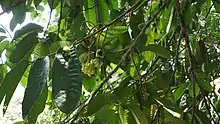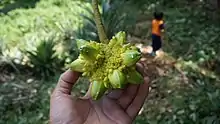| Prainea limpato | |
|---|---|
 | |
| Scientific classification | |
| Kingdom: | Plantae |
| Clade: | Tracheophytes |
| Clade: | Angiosperms |
| Clade: | Eudicots |
| Clade: | Rosids |
| Order: | Rosales |
| Family: | Moraceae |
| Genus: | Prainea |
| Species: | P. limpato |
| Binomial name | |
| Prainea limpato | |
| Synonyms | |
| |
Prainea limpato, also known as tampang susu in Malay and more locally as kesusu or empatak, is a species of flowering plant, a fruit tree in the fig family, that is native to Southeast Asia.[1]
Description

The tree grows to 30 m in height, with a bole of 2–4 m, with white latex. The leaves are 10–35 cm long by 4–15 cm wide. The globular inflorescences occur in the leaf axils. The syncarpous infructescences comprise 8–20 oval fruits, each 1.5–2 cm by 1 cm in diameter, projecting outwards from the core and ripening orange. The fruits are edible, with the orange aril tasting of bananas.[1]
Distribution and habitat
The species is found in the Malay Peninsula, Sumatra and Borneo, where it occurs naturally in lowland and hill mixed dipterocarp forest, as well as on limestone soils and along riverbanks, up to an elevation of 700 m. It is also planted in rural villages.[1]
References
- 1 2 3 Lamb, Anthony (2019). A guide to wild fruits of Borneo. Kota Kinabalu: Natural History Publications (Borneo). p. 174. ISBN 978-983-812-191-0.